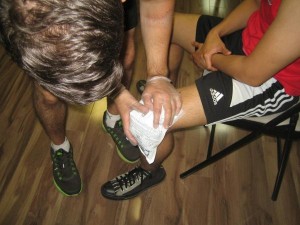Not all people love winter, but there are many adventure-seekers who look

forward for these cold months to try out some fun and exciting adventures on ice. There are many things you can do on ice. But before you immerse into any of these fun-filled winter activities, make sure you know how to respond in case accident occurs.
Disclaimer: ice safety is a major component of workplace approved Water Safety program as well as the first aid and CPR program. This post is for learning purposes only. To learn about preventing and re-acting to accidents involving ice enrol in workplace approved training programs.
Falling Through Ice
It is not surprising to note that the number of injuries and deaths due to falling through ice while skiing, skating or attempting to cross icy bodies of water increases every winter. Frequently, ice-related accidents become a multiple-rescue problem as untrained bystanders try to help the victims out of the ice. This results in increased weight over the ice, causing to crack and more people fall into the ice.
How to Help
Here are a few ways on how you can help a person who has accidentally fallen through ice:
- Throw in flotation devices towards the victim.
- Using a durable rope, create a loop and then toss it to the victim. Tell the victim to secure the loop around his body. Pull the victim away from the crevice towards a safe area.
- If available, use a small, flat-bottomed boat. Tie the rope on one side then push it towards the victim, stern first. The rescuer stands on a firm surface and holds the rope. Instruct the victim to get hold of the side of the boat. Pull the boat to safety.
- If available, use a ladder as an effective rescue tool for ice accidents. Tie a rope on the ladder. The ladder can be laid flat and then pushed towards the victim. Instruct the victim to grab the ladder then pull back the ladder. It can also be used to spread out the weight of the rescuer in case he needs to go to the victim’s aid. Make sure the ladder has a safety line before proceeding with any rescue attempt.
- If there is a need to crawl into the ice towards the victim, use a flat board to spread the rescuer’s weight over the ice. However, this is a very risky and should be done only when necessary.
When attempting ice rescue, remember that the victim may not be able to help during the process. Exposure to very low temperature, even for a few minutes, can have negative effects on the victim’s physical and mental capabilities. Hypothermia, which can have dramatic psychological and physical affects, will set in almost immediately after a victim falls into the ice.
Never attempt to enter through ice crevices to retrieve persons who have fallen through it. As much as possible, do not work alone when trying to help in ice-related accidents. If you are working alone, do not put yourself at risk by walking onto the ice; instead use the rope or ladder rescue methods. The best way to help in cases of accidents involving ice is for the rescuer to stay in a safe surface or the shore.
Be ready to provide first aid treatment for all victims of ice-related accidents. Try to keep victim warm and monitor for signs of shock.
Learn More
To learn more about ice safety and other environmental emergencies enrol in workplace approved training courses (sign up here).
Related Articles
